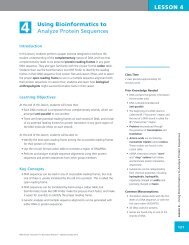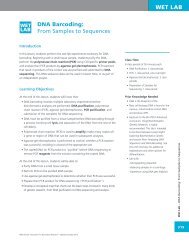Historical Case Studies and Student Guiding Questions - Northwest ...
Historical Case Studies and Student Guiding Questions - Northwest ...
Historical Case Studies and Student Guiding Questions - Northwest ...
You also want an ePaper? Increase the reach of your titles
YUMPU automatically turns print PDFs into web optimized ePapers that Google loves.
STUDENT HANDOUT 1.1dThe Willowbrook Study<strong>Case</strong> Study D: The Willowbrook StudyWarren was the fourth child <strong>and</strong> first boy born to a wealthy New York family in the 1950s. He was well loved by hissisters <strong>and</strong> parents. By the age of two it became obvious that Warren was different. When he was finally diagnosedas “profoundly retarded,” in the terms used at that time, his parents, who were unable to care for him, put him intoone of the best care homes in New York. The family eventually faced financial problems <strong>and</strong> Warren was moved toWillowbrook State Hospital.Willowbrook was opened in 1947 as a place to take care of New York’s mentally disabled population. Most patients weresent there as children when family doctors recommended that they needed more care than families could provide. Theinstitution was plagued with hepatitis outbreaks throughout its first decade of operation. Recent estimates show thatnearly 50% of patients living at Willowbrook in its early years of operation contracted hepatitis.When the study began in the mid-1950s, the distinction between the various types of hepatitis was not known.The conditions at Willowbrook led Dr. Saul Krugman <strong>and</strong> Dr. Robert McCollum to believe that it would be an ideal placeto study hepatitis to discover a possible cure for the disease. This could benefit both current <strong>and</strong> future children residingat Willowbrook. Letters describing the study were sent to parents of Willowbrook patients, asking permission for theirchildren to participate. The short letter described how some patients would receive antibodies called gamma globulinsthat researchers hoped would provide long-term protection against hepatitis. Parents could tour an improved residentialhospital wing set aside especially for study participants, meet with research staff, <strong>and</strong> ask questions about the study.Only children whose parents signed the permission form could participate in the study.The study included two groups. The first included patients such as Warren who had been living at Willowbrook for sometime, <strong>and</strong> were likely to get hepatitis whether they were in the study or not. The second group included patients who wereessentially healthy <strong>and</strong> were newly admitted to Willowbrook. Warren’s group had two categories: children who receivedthe antibodies, <strong>and</strong> children who did not. The healthy children who were new arrivals at Willowbrook all received theantibodies. During the study, some of the children unknowingly were deliberately infected with hepatitis by consuming thelive virus, which was extracted from the feces of infected children. Some children were not infected at all. The children whowere purposefully infected in the study tended to have milder reactions than children who contracted hepatitis naturallyfrom other children in the hospital. A public outcry ultimately closed the study in the 1970s.HANDOUTWarren was one of the last to leave Willowbrook when the facility closed in 1987. He now lives in a special care homewhere his sister communicates with him on a regular basis.The Willowbrook Study showed that hepatitis can be divided into multiple types, which has allowed doctors to specifythe type of treatment that is appropriate, <strong>and</strong> has led to a reduction in hepatitis outbreaks.This summary is based on a true story. Please see the Sources section for reference information.Contributed by Erin Larson, Federal Way School District, Federal Way, WA.Hepatitis: Inflammation of the liver caused most frequently by viruses.Antibody: A substance made by the body as an immune response that attacks <strong>and</strong> destroys foreign agents,such as viruses <strong>and</strong> bacteria.© <strong>Northwest</strong> Association for Biomedical Research26 | HUMANS IN RESEARCH
















